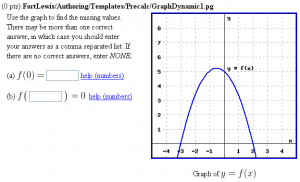Difference between revisions of "DynamicGraph1"
| Line 106: | Line 106: | ||
<p> |
<p> |
||
<b>Setup:</b> |
<b>Setup:</b> |
||
| − | For more details on the graph object <code>$gr</code>, see the help documents for graphs in the [IndexOfProblemTechniques|index of problem techniques]. |
+ | For more details on the graph object <code>$gr</code>, see the help documents for graphs in the [[IndexOfProblemTechniques|index of problem techniques]]. |
</p> |
</p> |
||
</td> |
</td> |
||
Revision as of 02:29, 4 December 2010
Dynamically Generated Graph
This PG code shows how to create a dynamically generated graph with labels that is appropriately sized and positioned.
- Download file: File:DynamicGraph1.txt (change the file extension from txt to pg when you save it)
- File location in NPL:
FortLewis/Authoring/Templates/Precalc/DynamicGraph1.pg
| PG problem file | Explanation |
|---|---|
|
Problem tagging: |
|
DOCUMENT(); loadMacros( "PGstandard.pl", "MathObjects.pl", "AnswerFormatHelp.pl", "PGgraphmacros.pl", "unionTables.pl", ); TEXT(beginproblem()); $refreshCachedImages = 1; |
Initialization:
It is important to set |
Context("Numeric");
$a = random(2,3,1); # left x-intercept
$b = random(2,4,2); # right x-intercept
$c = random(5,6,1); # y-intercept
$k = -($c)/($a * $b);
$A = $k;
$B = $k*($a - $b);
$C = -($k * $a * $b);
#
# Graph canvas
#
$gr = init_graph(-5,-1,5,9,axes=>[0,0],grid=>[10,10],size=>[300,300]);
$gr -> lb('reset');
#
# Graph labels and functions
#
$gr -> lb(new Label ( 4.5,0,'x','black','left','bottom'));
$gr -> lb(new Label ( 0.25,8.5,'y','black','left','bottom'));
$gr -> lb(new Label ( 0.25,$c,'y = f(x)','black','left','bottom'));
foreach my $i (1..4) {
$gr -> lb(new Label ( $i,-0.5, $i,'black','center','middle'));
$gr -> lb(new Label (-$i,-0.5,-$i,'black','center','middle'));
}
foreach my $j (1..8) {
$gr -> lb(new Label (-4.5,$j,$j,'black','center','middle'));
}
add_functions($gr, "$A*x**2+$B*x+$C for x in <-5,5> using color:blue and weight:2");
|
Setup:
For more details on the graph object |
Context()->texStrings;
BEGIN_TEXT
\{
ColumnTable(
"Use the graph to find the missing values.
There may be more than one correct answer,
in which case you should enter your answers
as a comma separated list. If there are no
correct answers, enter ${BITALIC}NONE.${EITALIC}
$BR
$BR
(a) \( f(0) = \) " .
ans_rule(7).$SPACE.
AnswerFormatHelp("numbers").
"$BR
$BR
(b) \( f \big( \) ".ans_rule(7)." \( \big) = 0 \). ".
AnswerFormatHelp("numbers")
,
image(insertGraph($gr), width=>300, height=>300, tex_size=>700).
$BR.$BCENTER.
$BR.
"Graph of \( y = f(x) \)".
$ECENTER
,
indent => 0, separation => 30, valign => "TOP"
)
\}
END_TEXT
Context()->normalStrings;
|
Main Text:
We use a two column format provided by
Using a |
$showPartialCorrectAnswers = 1; ANS(List($c)->cmp() ); ANS(List(-$a,$b)->cmp() ); |
Answer Evaluation: |
Context()->texStrings;
BEGIN_SOLUTION
${PAR}SOLUTION:${PAR}
Solution explanation goes here.
END_SOLUTION
Context()->normalStrings;
COMMENT('MathObject version.');
ENDDOCUMENT();
|
Solution: |
